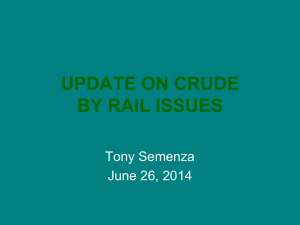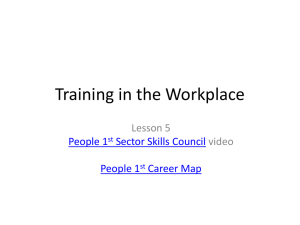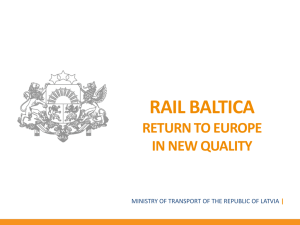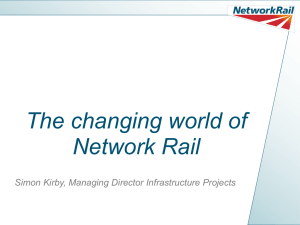making gender equality a reality in the south african rail industry by
advertisement
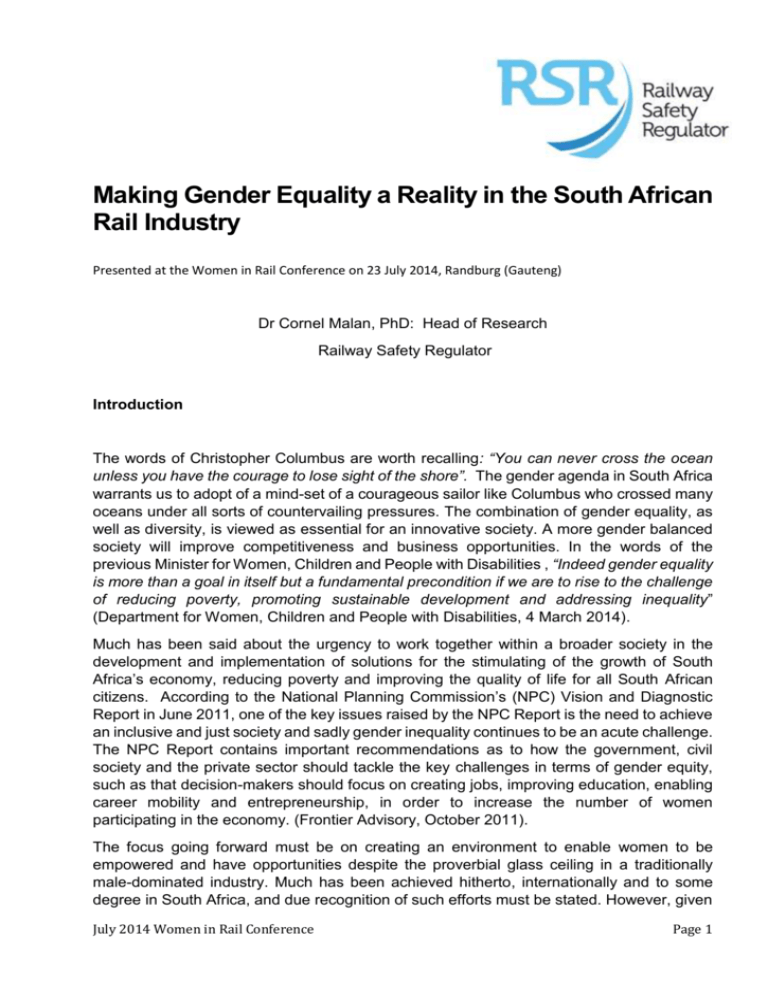
Making Gender Equality a Reality in the South African Rail Industry Presented at the Women in Rail Conference on 23 July 2014, Randburg (Gauteng) Dr Cornel Malan, PhD: Head of Research Railway Safety Regulator Introduction The words of Christopher Columbus are worth recalling: “You can never cross the ocean unless you have the courage to lose sight of the shore”. The gender agenda in South Africa warrants us to adopt of a mind-set of a courageous sailor like Columbus who crossed many oceans under all sorts of countervailing pressures. The combination of gender equality, as well as diversity, is viewed as essential for an innovative society. A more gender balanced society will improve competitiveness and business opportunities. In the words of the previous Minister for Women, Children and People with Disabilities , “Indeed gender equality is more than a goal in itself but a fundamental precondition if we are to rise to the challenge of reducing poverty, promoting sustainable development and addressing inequality” (Department for Women, Children and People with Disabilities, 4 March 2014). Much has been said about the urgency to work together within a broader society in the development and implementation of solutions for the stimulating of the growth of South Africa’s economy, reducing poverty and improving the quality of life for all South African citizens. According to the National Planning Commission’s (NPC) Vision and Diagnostic Report in June 2011, one of the key issues raised by the NPC Report is the need to achieve an inclusive and just society and sadly gender inequality continues to be an acute challenge. The NPC Report contains important recommendations as to how the government, civil society and the private sector should tackle the key challenges in terms of gender equity, such as that decision-makers should focus on creating jobs, improving education, enabling career mobility and entrepreneurship, in order to increase the number of women participating in the economy. (Frontier Advisory, October 2011). The focus going forward must be on creating an environment to enable women to be empowered and have opportunities despite the proverbial glass ceiling in a traditionally male-dominated industry. Much has been achieved hitherto, internationally and to some degree in South Africa, and due recognition of such efforts must be stated. However, given July 2014 Women in Rail Conference Page 1 the important role that the railway transport sector is to fulfil towards achieving National Development goals, the opportunities for creating a sustainable platform for gender equality must not be overlooked. This article aims to illustrate the benefits of a collaborative and integrated approach within the South African Railway Industry to move beyond the barriers of exclusion of women in the rail industry, towards making gender equality a reality for future generations to come. The article is based on a literature review of information available in printed media, official reports and publications. The intent is to review current activities within the South African Rail Industry, specifically those undertaken by the Railway Safety Regulator (RSR) as well as success stories in other industries. The article aims at illustrating the benefits on an integrated approach towards women empowerment in order to make gender equality a reality in the Rail Industry. Gender mainstreaming Research indicates that the following barriers to advancement of women generally exist in industries such as construction, mining and transport (including rail), where the occupations are mainly technical, work hours are irregular and the working environment is classified as risky or hazardous: The reluctance of employers to hire women, especially in technical positions, either as interns, graduates or permanent employees. Less favourable working conditions, e.g. in terms of wages, access to training, family unfriendly working hours, male‐centred ergonomic working conditions and the risk of violence and harassment. Cultural stereotypes that associate women and men with specific roles and tasks in the relevant sector. A male dominated sector that implies little experience and awareness with women’s issues and rights, i.e. maternity leave, hours of work, part time jobs, shift patterns etc. Poor health and safety surroundings, such as insufficient or lacking sanitary facilities and change rooms for women (Breengaard MH & University of Copenhagen, 2011). The above barriers are all indicative of a lack of a gender-integrative perspective, or socalled gender mainstreaming approach. The Women Empowerment and Gender Equity Bill, as adopted by Parliament in March 2014, defined gender mainstreaming as “the process of identifying gender gaps and making women’s, men’s, girls’ and boys’ concerns and experiences integral to the design, implementation, monitoring and evaluation of policies and programmes in all sectors of life to ensure that they benefit equally” (Department for Women, Children and People with Disabilities, 6 November 2013), in other words, gender mainstreaming means to integrate a gender equality perspective into all policy and planning processes to address imbalances and inequalities in processes where gender before has been invisible or regarded as not important. July 2014 Women in Rail Conference Page 2 A focus on gender mainstreaming consists of two main aspects, namely the integration of gender and equality perspectives in all policy and decision making processes and an integrated focus on an equal balance and representation of both women and men in all areas, including decision making, career development opportunities and supporting functions. In terms of ensuring gender and equality based policies and procedures, the South African Labour Law regulations have to a large degree dealt with this issue, by prohibiting all policies, procedures and practises that discriminate on ground of gender, race, etc. In terms of instilling an integrated focus, the overarching aim of gender mainstreaming in the rail industry would therefore be to ensure: Increased participation of women in all occupations, and including technical and operational professions Equal access to all railway professions Adequate workplace safety and security measures to allow women to work shifts as and when applicable Equal access to training and development opportunities A level playing field in the allocation of procurement opportunities to provide all types of services and goods to the rail industry An overall gender equality workplace culture (Breengaard MH & University of Copenhagen, 2011). In order to ensure the above listed gender equality objectives across the entire rail industry profile, it is proposed that the focus should be on the following main activities: Promoting a career in the rail industry, either as direct employee of one of the industry participants, or indirectly as an employee or owner of an entity providing services and/or goods. Promoting increased levels of education and training aimed at growing the number of women participants in the rail industry. Facilitating the absorption, career advancement and retention of women into the rail industry, though mentoring and coaching programs, and supported by an enabling environment free of discriminatory practises and culture. Transport as Enabler for Gender Equality Transport and its related services is a critical catalyst for economic growth, and direct and indirect job creation in South Africa. The provision of affordable, safe and reliable transportation of goods and people has been included in the critical national drivers for the development of the country. In his recent State of the Nation address, President Zuma specifically emphasises the role of rail as part of the National Infrastructure development program. He made special mention of the Transnet and PRASA rail projects, which are aimed at expanding and modernising the South African freight and passenger rail transport industry (The Presidency, 2014). Currently the division of labour is in the rail industry remains to be gendered and men are foremost represented in management, technical and operational functions whereas women July 2014 Women in Rail Conference Page 3 representation is largely in service and supporting areas. The current unequal gender representation remains a challenge towards a sustainable and innovative railway sector. Research has shown that companies with an equal balance of men and women are twice as innovative as other companies. Researchers calculate that businesses can boost their innovation capacity by 110% by increasing the share of women from 25% to 40%. A gender balanced workforce means that companies become far better at developing new products and services (Breengaard MH & University of Copenhagen, 2011). Given the demographics of South Africa, women represent 46% of the Economically Active Population (EAP) in South Africa, yet the unemployment level for women is higher than that for men. The EAP forms the basis of the workforce population distribution, as reported in the Quarterly Labour Force Survey (QLFS) published by Statistics South Africa and includes people from 15 to 64 years of age who are either employed or unemployed and who are seeking employment. The EAP is meant to assist employers during the analysis of their workforce to determine the degree of under-representation of the designated groups. The most recently published EAP data recommends that special efforts are required to increase the pool of women who are economically active, especially when they are the majority and are able to make more of a contribution towards the development of the South African economy (Department of Labour, 2014). This means that the focus should be on increased involvement of women, as they clearly represent a large part of the underutilised and available human resources in designing the future employment platform, and therefor also for the rail sector. Inclusion of women in the Rail industry happens in two areas, by direct employment, or by using women- owned entities for procurement purposes. Within the framework of the focus on infrastructure development as well as the resulting opportunities for inclusion of women in these projects, an inclusive, integrated and collaborative efforts between the various roleplayers is seen as essential, not only to achieve the targets of localisation and broad-based economic empowerment, but also to ensure that gender equality is fully entrenched as a way of doing business within the rail industry. In terms of employment opportunities, it is noteworthy to mention that the two mayor role players in the South African Rail industry have made significant strides towards the inclusion of women in their ranks. In terms of creating procurement opportunities, PRASA officially launched Women in Rail initiative aimed at providing women access to management of facilities, provision of professional services such as legal services, auditing, risk management etc. Career opportunities have also been provided to engineering graduates in areas such as rail technology, engineering services and rolling stock (PRASA, 2013). In a similar fashion the Transnet Group, through the Transnet Foundation, aims at investing in a wide range of socio-economic development programmes targeting vulnerable groups, with a particular focus on youth advancement and economic participation in the company’s economic activities in the communities in which Transnet has a direct impact, and beyond. This includes increased participation of black-women owned entities (Mail & Guardian, 2014). The Railway Safety Regulator (RSR) was established in terms of the National Railway Safety Regulator Act, Act 16 of 2002, as amended to establish a national regulatory framework for South Africa, and to monitor and enforce compliance within the rail sector July 2014 Women in Rail Conference Page 4 (RSR, 2013). As such, the RSR as an organisation does not provide for employment of a large number of people, or for large amounts to be spent on procurement, in comparison to the large rail industry role-players. However, the organisation does fulfil a vital role in making rail a safe and preferred mode of transport and therefor has a role to play in the way that the envisaged large infrastructure developments take place, including the involvement of women in a previously male-dominated area. The RSR as part of the government organ has an obligation to ensure that its own activities are aimed at creating gender equality, but also to encourage the industry at large to take such matters into consideration, in a similar fashion to the way that safety should be a major consideration in all new designs and ventures. Education to address the skills pipeline gaps South Africa’s Gender Equality Bill asserts the right sentiments, and in the words of the newly appointed Minister of Women, Children and People with Disabilities, Minister Susan Shabangu, “women must take centre stage as the country gears itself for the implementation of radical socio-economic transformation policies and programmes in the next five years” (SA Government News Agency, 2014). The first step is to focus on gender equality in education, since this builds the foundation for increasing the number of skilled, professional women entering the workplace. Evidence from the Nordic countries’ indicates that putting effort into enabling education paves the way for the successful introduction of quotas at work. Favouring women for technical jobs makes sense only if such people are available. The objective is to empower and increase the number of women in gainful employment. That means hiring skilled people for the job. In South Africa, a blanket target of 50% women could pose difficulties for sectors where two-thirds of workers are technical – such as in construction, infrastructure and information technology. A fixed 50% target is not realistic nor does attainable if the pool to recruit from not provide for sufficient number, there simply may not be enough women to fill half the positions in all types of jobs (Burmeister S, 2014). If we want gender empowerment to succeed, we must take into account the pipeline of young women coming into the workplace in a particular discipline. (Burmeister S, 2014). The simple solution then would appear to be to increase the pipeline numbers, but this has proven to be difficult, given the background of certain technical industries that have traditionally been viewed as male-dominated and not suited for female employment. Concerted efforts must be made to promote the rail industry as a career amongst female scholars, specifically to increase the number of female students pursuing a technical qualification. This meant that we needed to focus our attention on encouraging high potential maths and science high school students to pursue a career in engineering. South Africa is experiencing a severe skills shortage in the engineering sector and of the limited number of engineering professionals in the country, only a handful of these are female. Exxaro CEO Sipho Nkosi called the skills issue in South Africa a “national crisis”. The Solidarity Research Institute Report agreed that “there is definitely a skills shortage in South Africa, for Artisans, Technician and Engineers”. Some facts are: July 2014 Women in Rail Conference Page 5 South Africa now has 10% of the artisans it had 20 years ago There is a 40% shortage of artisans Griniker LTA has had to import welders from Malaysia, Ireland and India Sasol imported 1300 Thai artisans and welders SA has one engineer per 3200 people, compared to 1:130 in China, 1:270 in Europe, 1:450 in Australia. SA produces 1400 engineering graduates per year, against a demand for 2400 per year (Furter, 2013). It is common knowledge that South Africa has an imbalance between the levels of skills within the unemployed versus the skills required in the available jobs. A severe skills shortage in technical skills has had a crippling effect on the economy for a long period, The server lack of technical skills does not only impact on the ability to ensure skilled workforce, but also on the way that the industry conducts its business. In a recently published article, RSR Safety Regulator Risk and Corporate Governance Manager Stanley Khosa, and Senior Researcher Mabila Mathebula, voiced their concerns regarding the impact of skills shortages at rail operators in terms of transport safety risks. Based on their and investigations into recent accidents and incidents they highlight errors and violations of staff as primary causes. The article also states that the rail operator PRASA cited “an acknowledged shortage of key skills, as well as a lack of depth of skills in critical areas in PRASA.” Transnet has cited the loss of operational critical skills as one of their major risks (Furter, 2013). The Railway Safety Regulator, as part of its strategic drive to ensure that railway safety is effectively promoted, and to ensure sustainable institutional growth and development, has come to the realisation that promoting the rail industry as employer of choice, was not only the responsibility of the Department of Transport or its major industry operators such as Transnet, Prasa and Gautrain, but that all role players involved had a role to play. Countrywide initiatives are underway to address the various causes of the critical skills shortage. One such example is the research campaign by the Engineering Council of South Africa, to understand the challenges faced by tertiary institutions in achieving higher pass rates in engineering bachelor’s degrees (den Hartigh, 2012). Internal research conducted by the RSR regarding the extent of the skills shortage in South Africa, in an attempt to evaluate best practices around the world in order to come up with solutions for the South African rail industry, identified the following gaps: There is no comprehensive or shared picture of occupations, qualifications and skills in the rail industry. It is therefore difficult to determine the extent of any gaps between the level and types of skills currently held and those required in the future. There is no study of employee turnover intentions conducted so far in the rail industry. The National Railway Skills Academy is not being utilised to its full capacity to address skill shortages in the rail industry. There is no tracking system to track organisations or countries that are poaching our experienced workers. There has not been an audit of the rail industry workforce conducted hitherto that covers demographic data as occupations, age, tenure, gender and location July 2014 Women in Rail Conference Page 6 dimensions; and attraction and retention data such as number of vacancies, areas of critical shortages, and new entrance to the industry and turnover rates. The following were recommendations that came out of the study: A comprehensive audit of the rail industry workforce, covering rail operators, maintenance providers, relevant government departments and agencies and the manufactures and component supply sector should be undertaken. Identify retired experienced rail personnel to act as mentors and coaches to rail workers in all aspects of the rail industry. The industry should visit schools as well as FET Colleges and ‘preach’ the ‘gospel’ of careers in the railways. South Africa should investigate the possibility to establish a National Railway Skills Academy to deal with the shortage in the industry (Note: the Railway Academy has subsequently been revived and students are being sponsored by TFR towards a career in the rail industry). In terms of the third recommendation, the RSR therefore actively participates in campaigns aimed at increasing the awareness for the rail industry through education, communication and training initiatives within the community. Examples of such include the October 2013 Eastern Cape Career Open Day, entitled “Empowering the nation though education for the future” in Port Elizabeth, with the view to introducing learners to possible career options to pursue after matric. In similar vein, the RSR exhibition at the official opening event of the R81 road in Polokwane attracted the attention of a large number of community members and university students from Limpopo ((RSR, Nov 2013). These events aim to create a higher level of awareness of the career opportunities within rail, but also to provide information regarding possible bursaries and internships, aimed at attracting the top performers in maths and science into engineering-related tertiary studies. Eradicating gender bias in the rail sector should also include the employee training and development system. Career progression and specialisations often have a significant gender bias, which obviously makes gender‐balanced recruitment and retention more difficult. In this respect, the development of gender‐balanced development practices for students are crucial. Training programmes can be a means to qualify women to positions where they are missing, such as jobs in the operational part of the industry (Breengaard MH & University of Copenhagen, 2011). In terms of developing a pipeline for future employment, the RSR Bursary scheme aims at assisting employees who wish to further their studies and acquire nationally recognised qualifications. Currently all bursars are female, clearly indicating a commitment to creating a more equitable workforce going forward. In addition to the bursars, inters are also given exposure and world-of-work experience in the various departments within the RSR. The current total number of 17 interns comprise of 12 females across the various disciplines, and in terms of the more technical skills required in areas such as Operations, Permits and Standards and Investigation, 50% of the interns are female. It is also important to note that the RSR also offers a Trainee Inspector Apprentice Program. After serving the twelve month Traineeship, the successful trainees are then July 2014 Women in Rail Conference Page 7 absorbed to be developed as Junior Railway safety Inspectors over a two-year period. To date, two female apprentices have been appointed as trainee inspectors. Expanding opportunities for Women Entrepreneurs Women play an important role in the entrepreneurial economy, both in their ability to create jobs for themselves and to create jobs for others. Enterprising new businesses have been found to drive economic growth (Beaulieu, 2002; Emery, Wall and Macke, 2004) and women entrepreneurs have also become important contributors to that growth (Warren-Smith and Jackson, 2004; Marret and Gruidl, 2000). However, women in Africa have been said to be culturally marginalised in terms of their basic human rights that include education, employment, property rights (African Leadership Forum, 1990, Chitsike, 2000; Meena, 1999; Kapunga, 2008). The said marginalisation of women is said to have affected their ability to fully utilise their intellectual energies in the management of the economies. According to Meena (1993), marginal participation of women in education and particularly in institutions of higher learning, women are holed into these disciplines which groom them for traditional roles such as nursing, community service, or secretarial work (traditionally, the secretarial role in the railways was enacted by women). She further highlights that very few women have access to institutions of higher learning and those who do, enter specific stereotyped fields. As a result women will continue playing very marginal roles in decisions regarding the laws of the land, science and technology, and whatever they want to further their education, or start a business. They would prefer programmes or the type of business that would leave her with time to look after and attend to family issues as they bear more household and parenting responsibilities than men. Most women have failed to secure loans from banks or other financial institutions because of lack of collateral since most of the property is in the name of a man or husband (Mtisi, 2004), thus it becomes difficult for one to start or own a business. The African Leadership Magazine (1990) quotes studies that highlighted that women are absent in the upper echelons of organisations as well as specific professional disciplines like technical and commercial sectors. The few who make it to the top are viewed as being on a “dangerous cliff” or “greasy pole” and in the African context, earn labels as “unfeminine” or “social males”. Another problem identified from the literature that affects women business growth is market accessibility. According to Meena (1993) women entrepreneurs often face difficulties in gaining market access as their products do not enjoy comparative advantage. They are unable to meet either requirements or environmental regulations imposed by markets due to their inadequate skills, low level of technologies and production techniques. Lack of modern marketing techniques or information further hampers them to export their products. July 2014 Women in Rail Conference Page 8 The lack of relevant skills/experience is another thorny issue. The lack of relevant skills seems common to female entrepreneurs in South Africa and this poses a serious challenge to the development of their businesses. They can be directly attributed to the lack of appropriate skills in the management of business. Deficient training is one of the greatest barriers preventing female businesses from growing. The OECD (2000) shows that all stages in entrepreneurship are dependent on relevant experience from the identification of opportunities to the execution of running a business. This is in agreement with the Human capital theory, which stipulates that individuals with more or higher human capital achieve higher performance in executing relevant tasks (Brush and Hirsch, 1999). However, current treads reveal that women are beginning to break the “glass ceiling” by getting more and more economically active, albeit with both cultural and economic barriers affecting their efforts despite the universal promise towards women empowerment in the pursuit of the Millennium Development Goals (MDG3) set by the United Nations Development Fund (Organisation for Economic Co-operation and Development – OECD, 2004). In addition to creating employment opportunities with the rail industry, creating awareness regarding entrepreneurial opportunities could also attract those who wish to pursue a career in provision of services and goods, rather than as a direct rail industry employee. The growth engine of any developing economy is the development of entrepreneurs, and the importance of increasing such cannot be overstated. As already discussed, the discourse between skills available and skills required has resulted in the structure of the labour market not been conducive to higher employment levels. A contributing factor to this and, hence, to the unemployment problem is also that the small, micro and medium enterprise (SMME) sector is not large enough and has not absorbed as much labour as it should. This is partly because of historical and new barriers to the growth and formalisation of microenterprises among the previously disadvantaged population, and will require intensive commitment from all the industry partners going forward. In the European Union (EU), SMMEs of under 250 people make up more than 90% of companies, and employ 65 million people. In many sectors, SMMEs are also responsible for driving innovation and competition. In India, Micro and Small Enterprises are estimated that, in terms of value, the sector accounts for about 39% of the manufacturing output and around 33% of the total exports of the country (BUSA, 2010). South Africa needs to boost informal, small and medium businesses as probably as much as 80% of the jobs needed to reduce unemployment will come from these sectors. It is therefore clear that SMME development and entrepreneurship are crucial areas in improving economic development and implementing government pro-poor policies successfully, as well as achieving the National Development Plan Goals (BUSA, 2010). Integrative approach to Gender Mainstreaming July 2014 Women in Rail Conference Page 9 As previously stated, great strides have already been taken into the creation of opportunities for women involvement, either through provision of bursaries, internships, employment or through procurement opportunities. But to an extent, this has been done in isolation, as each entity has its own program, impressive as some might be, but there appears to be a lack of collaboration and integration amongst the government, industry operators and other roleplayers such as tertiary institutions, entrepreneurial development agencies and similar organisations. There is no need to reinvent the wheel, there are success stories of women in senior positions, in highly skilled and technical occupations, leading large projects in industry. But what is sadly lacking, is the ability to integrate the various initiatives. And again, this would not require new designs, new ideas or new approaches. Other industries have managed to integrate efforts across various role-players to successfully develop and retain women in technical occupations, by providing opportunities through an integrated internship / graduate program for female students to rotate and gain exposure in various roles and appointments within various organisations. In doing so, not only did the level of innovation increase, but a gradual cultural shift towards gender equality became evident as time progressed (Malan, 2011). During a recent discussion with a female entrepreneur who desperately wishes to gain access to the rail industry, it became apparent that the notion still prevailed that women entrepreneurs are focused on provision of goods and services such as stationary, office equipment and recruitment services, but not in more technical areas such as provision of steel, rolling stock parts, maintenance etc. The barriers to the inclusion and growth of women-owned SMME’s are also in terms of “competing with the giants”, especially in the areas such as steel manufacturing, construction etc., where large scale tenders and contracts exclude the emerging SMME’s for becoming part of the solution. As recommended by Business Unity South AFRICA (BUSA in their report on creating inclusive growth in South Africa, there is a need to seek to expand the value chain of public and private services by maximising procurement links with SMMEs through sub-contracting, out sourcing and joint ventures where possible, to stimulate a culture of entrepreneurship (BUSA, 2010). South Africa has come a long way since the country emerged from isolation in 1994. But we face a set of tough choices that have to be made if the country is to achieve the kind of economic growth rates that can meaningfully expand the economy and reduce unemployment and poverty. Collaboration of efforts and minds is essential to achieve higher growth rates, which means improving the country’s competitiveness and innovation ability. No stakeholder can do this by themselves. Only through a collective effort, can the issue of gender mainstreaming be successfully dealt with. “Discrimination in the world of work not only constitutes an abuse of fundamental principles and rights at work, but is of huge cost to society. If no remedial action is taken, disadvantages tend to accumulate and intensify over time, with negative repercussions on life after work – and on society more generally” (International Labour Organisation report on “ Time for equality at work” as presented at the International Labour Conference, First Session, Geneva, 2003.) July 2014 Women in Rail Conference Page 10 References 1. African Leadership Magazine Forum, 1990 2. Beaulier B. & Lionel J. “Creating Vibrant Communities and Economies in Rural America. Southern Rural Development Centre. Publication # 225 3. Breengaard MH & University of Copenhagen. (2011, July 07). Women in Railways: perspective, issues and opportunities. Retrieved from The Co-ordination for Gender Research, University of Copenhagen (UCPH): http://www.transport-research.info/ 4. Brush. C.G and Hirsch, R.D (1991). Antecedent Influences on Women-Owned Business. Journal of Management Psychology, 6 (2), 9-16. 5. Burmeister S. (2014). Still too few women in top jobs. Retrieved from HR Future.net: http://www.hrfuture.net/daily-article/still-too-few-women-in-top-jobs2.php?Itemid=114 6. BUSA. (2010). Perspectives for an Inclusive Higher Job Growth Path for SA by 2025. Johannesburg: Business Unity South Africa. 7. Commission for Employment Equity. (2014). Commission for Employment Equity report 2013 -2104. Retrieved from Department of Labour: www.labour.gov.za/DOL/downloads/...equity/.../14ceereport_part3.pdf 8. Den Hartigh, W. (2012, March 26). More women engineers for South Africa. Retrieved from Media Club South Africa: http://www.mediaclubsouthafrica.com/youth-and-education/2820engineering#ixzz36xNjwHmE 9. Department for Women, Children and People with Disabilities. (4 March 2014). “Celebrating 20 Years of Women’s Progress in South Africa”. Key Note address by Minister Lulu Xingwana, at the Women's National Consultation Conference. Southern Sun OR Tambo Hotel, Kempton Park. 10. Department for Women, Children and People with Disabilities. (6 November 2013). Women Empowerment and Equity Bill. Pretoria: Government Gazette No. 37005. 11. Department of Government Communication and Information Systems. (2011). Pocket Guide to South Africa 2011/12. Retrieved from Department of Government Communication and Information Systems: http://www.gcis.gov.za 12. Department of Labour. (2014). 14th Commission for Employment Equity Annual Report 2013/2014. Pretoria: Chief Directorate of Communication: Government Publications. 13. Emery, M. Milan, W. and Don, M. (2004). “From Theory to Action: Energising Entrepreneurship (E2). Strategies to Aid Distressed Communities Grow on Their Own. Journal of the Community Development Society 35 (1): pp 82-96 14. Frontier Advisory. (October 2011). The Status of Women in South Africa, A preliminary report incorporating the findings of consultative roundtable discussions July 2014 Women in Rail Conference Page 11 on Women Empowerment in South Africa. International Women’s Forum South Africa. 15. Furter, E. (2013, January 10). Regulator finds dire SA rail safety skills shortage. Retrieved from sheqafrica.com: http://sheqafrica.com/rail-safety-skills-shortage/ 16. Kapunga R.S. (2008). CIPE Magazine, The Pursuit of Higher Education in Zimbabwe: A futile Effort? CIPE: New York. 17. Mail & Guardian. (2014, April 24). Expanding opportunities in youth advancement. Retrieved from Mail & Guardian: http://mg.co.za/article/2014-04-10-expandingopportunities-in-youth-advancement 18. Malan, C. (2011). Mining with Women in Mind- the need to change the culture of mining to drive diversity in the industry. MTS Transformation Journal, 32. 19. Meena, R. (1993). Southern African Political and Economic Monthly (SEPEM) Vol 4 no 12. Harare, Zimbabwe. 20. Merrett, C.D. & Gruidl, J.J. (2000). Small Business Ownership in Illinois: The Effect of Gender and Location on Entrepreneurial Success, Professional Geographer, 52 (3) 21. Mtisi, S. (2004). “Women in Business Needs Assessment Report, SNV Netherlands Development Organisation [unpublished]. 22. PRASA. (2013). Women in Rail Information Sessions. Passenger Rail Agency of South Africa. 23. OECD (2000). Women Entrepreneurship in SMEs realizing the benefits of Globalised and the knowledge based Economy. Parsi, OECD. 24. OECD (2004). Promoting entrepreneurs And Innovative SMEs in a Global Economy. Paris. OECD. 25. RSR. (2013). Railway Safety Regulator Strategic & Annual Performance Plan 2014/2019. Pretoria: Government Printing Works. 26. RSR. (Nov 2013). RSR Communication Report - November 2013. Centurion: RSR. 27. SA Government News Agency. (2014, June 6). Women must take centre stage in the economy of the Country. Retrieved from SA News: http://www.sanews.gov.za/southafrica/women-must-take-centre-stage-sas-economy 28. The Presidency. (2014, June 17). State of the Nation Address by His Excellency Jacob G Zuma, President of the Republic of South Africa on the occasion of the Joint Sitting of Parliament Cape Town. Retrieved from South African Government Online: http://www.gov.za/speeches/view.php?sid=46120 29. Warren, S. & Catherine, J. (2002). Women Creating Wealth through Rural Enterprise. International Journal of Entrepreneurship and Research, Vol 10, No 6. Emerald Group Publishing, P369-383. July 2014 Women in Rail Conference Page 12





